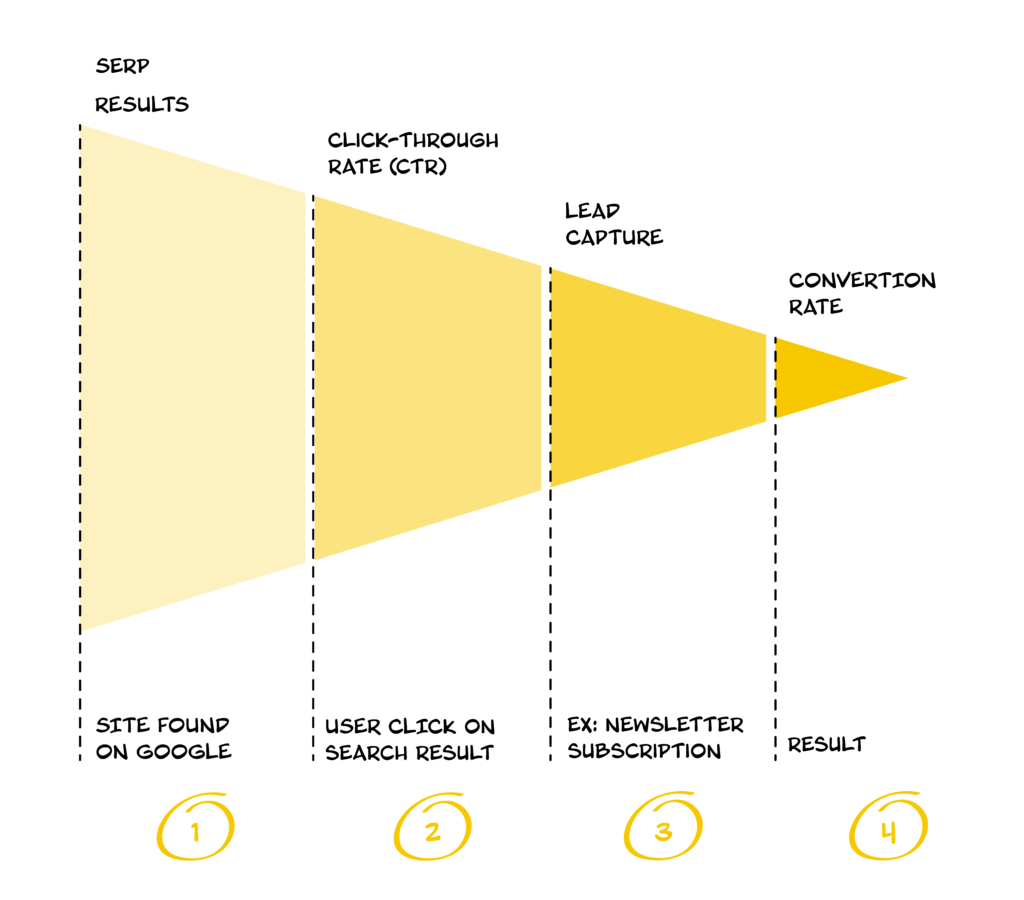8.5 billion Google searches are made every day. That’s 100k queries every second!
In today’s digital landscape, a well-thought-out SEO (Search Engine Optimization) strategy is no longer optional—it’s a fundamental part of any successful business strategy. Especially for small business that don’t have the resources of larger corporations.
Whether you’re a small business owner or part of a larger enterprise, leveraging SEO effectively can significantly improve your website’s results, from increasing traffic to boosting conversions. Let’s dive into how a robust SEO strategy can directly impact your business outcomes.
When you make a search on Google, you see a list of results. These are used to be mostly a list of websites, with its titles and descriptions linking to the destination website. Nowadays, is a little bit more complex. Google might sometimes present you with answers to your query question. Other times shows you maps, reviews and more information than you asked, presenting you, the user, with a rich set of results.
These results all link to the websites that present the best answers… Our goal? Make one of these answers yours!
Let’s step into the details of how to create a wining SEO strategy for your small business.

Step 1: Create contents for quality, not quantity
Before I delve into the details of how you can improve your small business SEO strategy, let me be clear: you should aim for quality, not quantity. Unless you sell ads on your website or have a megastore that sells everything, you should be as niche and specific as possible.
There’s even a term for this, it’s called “long tail keywords”, where you optimize your SEO strategy for keywords that go from three to five words, where it’s easier to rank higher and bring more qualified users to your website – and this means better business results.
Define your target audience
While this article is all about designing the best SEO strategy and that means pleasing Google Search, you should always be thinking about your audience, not Google.
When you make content with your audience in mind, your users will be happy, and Google will follow. And to please your visitors you must know who they are, so, first and foremost, define a clear target audience for your site. Find out what they like, what’s makes them happy and what can be useful to them. Put yourself in their shoes when creating a piece of content and make it relevant for them.
Create original, relevant content
Make sure your content is personal and not AI generated. I’m not mentioning this because of Google penalties for AI content but for the sake of improving your business results. If you create authentic and relevant content for your users, they will “repay” you by reading your content or viewing your videos. Why? They will empathize with you – and that will generate leads and results, so everyone is happy! This is especially true for small business where it’s easier to build a relation on a more personal level.
Set a goal for each article
Avoid writing without a purpose. Plan before writing. Do you want to sell something? Do you want to help someone? Do you want to build a community? Define a clear intent so you can optimize your call-to-actions, (CTAs) and make them aligned with the article you are writing.
In step 3 I’ll explain how these CTAs are important to create user relationships and later, to convert. If your article is about explaining something, it will feel disingenuous to try to sell your product – it would make more sense to ask the users to subscribe your newsletter. That way you can send them an email with helpful tips and information, maybe leading them to buy something more in the future.
In a real-life conversation if you share advice with someone, you won’t try to sell them your advice. You might say “call me if you need help”, showing you always there for them. That’s what your users want.
Building confidence is also about improving your conversion rates but there’s a time and place for everything.
Step 2: Enhancing Click-Through Rate (CTR) in the SERPs
Let me translate this tile into plain English: Getting more people to your website when you appear on a search result. Your Click-Through Rate (CTR) measures how effectively your website entices users to click on your link in search engine results pages (SERPs). Here’s how SEO can help improve your CTR:
Crafting Attention-Grabbing Titles and Meta Descriptions
Optimize your title tags to be descriptive and include primary keywords. The page title have a direct impact on the page ranking and you should use clear, concise titles that are in sync with the page content.
Write concise and compelling meta descriptions that highlight the value proposition of your content. The meta descriptions won’t make your website rank higher but are very important to improve the CTR of your website on Google.
Leveraging Rich Snippets
Use structured data to enable rich results, such as star ratings, FAQs, or product information, making your listing stand out. Rich Snippets have become more important as AI or generative engines (Perplexity, ChatGPT and Gemini).
Testing and Refining Headlines
Perform A/B testing to identify which headlines generate the highest CTR. Don’t use click bait or trick users to click just to find a content that doesn’t match the title. Remember, aim for quality, not quantity. You want satisfied users that might convert, not frustrated ones that leave a high bouncing rate.
By optimizing these elements, you increase your chances of attracting not just visitors to your site, but also possible clients.
Step 3: Don’t try to sell too fast
Most users won’t buy anything on their first visit to a website. Sorry, but that’s the reality! This doesn’t mean you can’t start a conversation.
A lot of websites try to get you to buy their product as soon as possible – like a salesman on the subway. If you show your possible clients what you can offer them, what you can teach, start a conversation, they might subscribe to your newsletter. What does that give you? A change to give more information and they can a little bit more about their purchase decision. A newsletter subscription is free, and they cancel anytime! It’s a win-win situation.
You can start building a relationship with your users and don’t lose touch with them this way. It’s like calling a friend from time to time just to catch up. In the marketing world this is called Lead Nurturing and it’s an opportunity to provide value to your leads and customers and help them grow with your business.
Step 4: Improving Conversion Rates on Your Website
As we saw by now, driving traffic to your website is only the first step. Converting visitors into customers is the ultimate goal. Here’s how SEO can influence conversion rates:
Delivering Relevant Content
Align your content with user intent. If your target audience is searching for solutions, provide actionable advice and answers.
Enhancing User Experience (UX)
Optimize website speed, mobile responsiveness, and navigation to ensure visitors have a seamless experience.
Reduce bounce rates by making information easy to find.
Optimizing Call-to-Actions (CTAs)
Place clear and compelling CTAs strategically throughout your site to guide users toward your desired action. Remember not all CTAs must direct the users to the purchase decision. Some visitors might just want to subscribe a newsletter to keep in touch with your business, others might want to book a call before making a purchase decision. Test these options and optimize the conversion rates on these CTAs.
Building Trust with SEO Signals
Build backlinks from reputable sources to build credibility. A great piece of content can go a long way to make others link to your site, but there are other ways to get links to your site – use with caution.
Use HTTPS for secure browsing and display customer reviews prominently.
Next Steps: Testing and Iterating for Better Results
Continuous testing is key to maximizing the impact of your SEO efforts. Here’s how to approach it:
Testing CTR Improvements
Use Google Search Console to identify pages with high impressions but low CTR.
Experiment with different title tags and meta descriptions to see what drives more clicks.
A/B Testing for Conversion Rates
Test variations of landing pages to identify elements that resonate with your audience.
Experiment with different CTAs, layouts, or images to boost engagement.
Monitoring Performance Metrics
Use tools like Google Analytics to track user behavior, such as time on page, bounce rates, and conversion paths.
Adjust your strategies based on insights and trends.
Preparing for GEO (Generative Engine Optimization)
As AI-powered search evolves, Generative Engine Optimization (GEO) is becoming a crucial aspect of SEO. Here’s how small businesses can prepare for this shift:
Optimizing for AI-Powered Search Results
Focus on creating detailed, well-structured content that AI models can easily parse and use to generate answers.
Use schema markup to provide clear context and relationships between data points on your site.
Creating Conversational Content
Write content that answers questions naturally, mimicking conversational queries AI systems often process.
Incorporate long-tail keywords and question-based phrases that align with how users interact with AI tools.
Ensuring Data Accuracy
Keep your business information up-to-date, including contact details, product descriptions, and service offerings.
Verify your presence in knowledge graphs and ensure your business appears correctly in AI-driven summaries.
Focusing on Visual and Multimedia Content
Enhance your content with images, videos, and infographics that AI systems can utilize for richer results.
Use descriptive alt texts and captions to make multimedia assets more discoverable.
By proactively aligning your SEO efforts with GEO best practices, small businesses can stay ahead of the curve and maintain visibility in an increasingly AI-driven search environment. The good news is that many of these topics only require minor adjustments.
The Strategic Benefits of SEO
By improving CTR, conversion rates, and continuously optimizing your strategy, SEO has the potential to
- Increase brand visibility and authority in your industry.
- Drive high-quality, qualified, traffic to your website.
- Enhance user engagement and satisfaction.
- Create and nurture relationships with your brand.
- Generate measurable ROI over time.
SEO is not a one-time effort but an ongoing process of refinement and optimization. For small businesses, it represents an opportunity to compete with larger players by building a strong digital presence. Make your content more personal and original and make that your superpower. By focusing on improving Google Search CTR, boosting conversion rates on your website, and rigorously measuring and testing your approaches, you can create an SEO strategy that aligns with your business goals and delivers tangible results.


